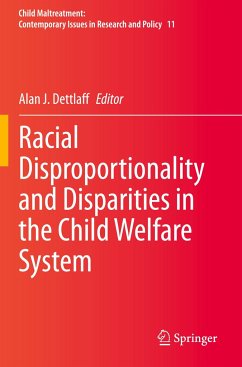Racial Disproportionality and Disparities in the Child Welfare System
Herausgegeben:Dettlaff, Alan J.
Racial Disproportionality and Disparities in the Child Welfare System
Herausgegeben:Dettlaff, Alan J.
- Broschiertes Buch
- Merkliste
- Auf die Merkliste
- Bewerten Bewerten
- Teilen
- Produkt teilen
- Produkterinnerung
- Produkterinnerung
This volume examines existing research documenting racial disproportionality and disparities in child welfare systems, the underlying factors that contribute to these phenomena and the harms that result at both the individual and community levels. It reviews multiple forms of interventions designed to prevent and reduce disproportionality, particularly in states and jurisdictions that have seen meaningful change. With contributions from authorities and leaders in the field, this volume serves as the authoritative volume on the complex issue of child maltreatment and child welfare. It offers a…mehr
Andere Kunden interessierten sich auch für
![Anti-Semitism and Schooling Under the Third Reich Anti-Semitism and Schooling Under the Third Reich]() Gregory WegnerAnti-Semitism and Schooling Under the Third Reich46,99 €
Gregory WegnerAnti-Semitism and Schooling Under the Third Reich46,99 €![Building Bridges Across the Racial Divide Building Bridges Across the Racial Divide]() Larry FeldmanBuilding Bridges Across the Racial Divide114,80 €
Larry FeldmanBuilding Bridges Across the Racial Divide114,80 €![Interrogating Whiteness and Relinquishing Power Interrogating Whiteness and Relinquishing Power]() Interrogating Whiteness and Relinquishing Power43,10 €
Interrogating Whiteness and Relinquishing Power43,10 €![Building Bridges Across the Racial Divide Building Bridges Across the Racial Divide]() Larry FeldmanBuilding Bridges Across the Racial Divide41,00 €
Larry FeldmanBuilding Bridges Across the Racial Divide41,00 €![Handbook of the Sociology of Racial and Ethnic Relations Handbook of the Sociology of Racial and Ethnic Relations]() Handbook of the Sociology of Racial and Ethnic Relations39,99 €
Handbook of the Sociology of Racial and Ethnic Relations39,99 €![America's Atonement America's Atonement]() Aaron David GressonAmerica's Atonement36,55 €
Aaron David GressonAmerica's Atonement36,55 €![The Impact of 9/11 on Psychology and Education The Impact of 9/11 on Psychology and Education]() M. MorganThe Impact of 9/11 on Psychology and Education40,99 €
M. MorganThe Impact of 9/11 on Psychology and Education40,99 €-
-
-
This volume examines existing research documenting racial disproportionality and disparities in child welfare systems, the underlying factors that contribute to these phenomena and the harms that result at both the individual and community levels. It reviews multiple forms of interventions designed to prevent and reduce disproportionality, particularly in states and jurisdictions that have seen meaningful change. With contributions from authorities and leaders in the field, this volume serves as the authoritative volume on the complex issue of child maltreatment and child welfare. It offers a central source of information for students and practitioners who are seeking understanding on how structural and institutional racism can be addressed in public systems.
Produktdetails
- Produktdetails
- Child Maltreatment 11
- Verlag: Springer / Springer International Publishing / Springer, Berlin
- Artikelnr. des Verlages: 978-3-030-54316-7
- 1st edition 2021
- Seitenzahl: 456
- Erscheinungstermin: 28. November 2021
- Englisch
- Abmessung: 235mm x 155mm x 23mm
- Gewicht: 769g
- ISBN-13: 9783030543167
- ISBN-10: 3030543161
- Artikelnr.: 62861842
- Herstellerkennzeichnung Die Herstellerinformationen sind derzeit nicht verfügbar.
- Child Maltreatment 11
- Verlag: Springer / Springer International Publishing / Springer, Berlin
- Artikelnr. des Verlages: 978-3-030-54316-7
- 1st edition 2021
- Seitenzahl: 456
- Erscheinungstermin: 28. November 2021
- Englisch
- Abmessung: 235mm x 155mm x 23mm
- Gewicht: 769g
- ISBN-13: 9783030543167
- ISBN-10: 3030543161
- Artikelnr.: 62861842
- Herstellerkennzeichnung Die Herstellerinformationen sind derzeit nicht verfügbar.
Alan J. Dettlaff is Dean of the Graduate College of Social Work at the University of Houston and the inaugural Maconda Brown O'Connor Endowed Dean's Chair. Prior to joining the University of Houston, Dean Dettlaff served on the faculty of the Jane Addams College of Social Work at the University of Illinois at Chicago. He received his bachelor's degree in social work from TCU, and master's in social work and PhD from the University of Texas at Arlington. Dean Dettlaff's research focuses on improving outcomes for children and youth in the child welfare system by examining and addressing issues of structural and institutional racism that contribute to racial inequities in this system..
Part 1. Understanding and Identifying Disproportionality and Disparities.- Chapter 1. Historical Overview of Disproportionality and Disparities (Alan Dettlaff).- Chapter 2. Measurement Issues in Identifying and Describing Disproportionality and Disparities (Nancy Rolock).- Chapter 3. Disproportionality and Disparities Among African American Children (Reiko Boyd).- Chapter 4. Disproportionality and Disparities Among Latino Children (Michele Johnson-Motoyama).- Chapter 5. Disproportionality and Disparities Among Native American Children (Terry Cross).- Chapter 6. Underrepresented Populations in the Child Welfare System (Rowena Fong).- Part 2. Explaining Disproportionality and Disparities.- Chapter 7. Racial Bias as an Explanatory Factor (Ruth McRoy).- Chapter 8. Disproportionate Need as an Explanatory Factor (Brett Drake).- Chapter 9. Child Welfare System Issues as Explanatory Factors (Susan Wells).- Chapter 10. Geographical Context as an Explanatory Factor (Fred Wulczyn).- Part 3.Consequences of Disproportionality and Disparities.- Chapter 11. Individual Consequences of Disproportionality and Disparities (Mark Courtney).- Chapter 12. Community Consequences of Disproportionality and Disparities (Dorothy Roberts).- Part 4. Preventing and Reducing Disproportionality and Disparities.- Chapter 13. Preventing Child Maltreatment Among Children of Color (Brenda Jones Harden).- Chapter 14. Workforce Development Strategies to Address Racial Bias (Anita Barbee).- Chapter 15. Family Group Decision Making to Reduce Disproportionality and Disparities (Donn Baumann).- Chapter 16. Using the Decision Making Ecology to Identify and Address Disproportionality (John Fluke).- Chapter 17. Courts Catalyzing Change: Working with Court Systems to Address Disproportionality and Disparities (Jesse Russell).- Chapter 18. Using the Institutional Analysis to Facilitate Systems Change (Kristen Weber).- Chapter 19. Creating Comprehensive System Reform: The Texas State Strategy (Rowena Fong).-Chapter 20. Legislative Solutions to Address Disproportionality (Jessica Dixon Weaver).- Part 5. Conclusion and Future Directions.- Chapter 21. Future Directions in Policy, Practice, and Research (Alan Dettlaff).
Part 1. Understanding and Identifying Disproportionality and Disparities.- Chapter 1. Historical Overview of Disproportionality and Disparities (Alan Dettlaff).- Chapter 2. Measurement Issues in Identifying and Describing Disproportionality and Disparities (Nancy Rolock).- Chapter 3. Disproportionality and Disparities Among African American Children (Reiko Boyd).- Chapter 4. Disproportionality and Disparities Among Latino Children (Michele Johnson-Motoyama).- Chapter 5. Disproportionality and Disparities Among Native American Children (Terry Cross).- Chapter 6. Underrepresented Populations in the Child Welfare System (Rowena Fong).- Part 2. Explaining Disproportionality and Disparities.- Chapter 7. Racial Bias as an Explanatory Factor (Ruth McRoy).- Chapter 8. Disproportionate Need as an Explanatory Factor (Brett Drake).- Chapter 9. Child Welfare System Issues as Explanatory Factors (Susan Wells).- Chapter 10. Geographical Context as an Explanatory Factor (Fred Wulczyn).- Part 3.Consequences of Disproportionality and Disparities.- Chapter 11. Individual Consequences of Disproportionality and Disparities (Mark Courtney).- Chapter 12. Community Consequences of Disproportionality and Disparities (Dorothy Roberts).- Part 4. Preventing and Reducing Disproportionality and Disparities.- Chapter 13. Preventing Child Maltreatment Among Children of Color (Brenda Jones Harden).- Chapter 14. Workforce Development Strategies to Address Racial Bias (Anita Barbee).- Chapter 15. Family Group Decision Making to Reduce Disproportionality and Disparities (Donn Baumann).- Chapter 16. Using the Decision Making Ecology to Identify and Address Disproportionality (John Fluke).- Chapter 17. Courts Catalyzing Change: Working with Court Systems to Address Disproportionality and Disparities (Jesse Russell).- Chapter 18. Using the Institutional Analysis to Facilitate Systems Change (Kristen Weber).- Chapter 19. Creating Comprehensive System Reform: The Texas State Strategy (Rowena Fong).-Chapter 20. Legislative Solutions to Address Disproportionality (Jessica Dixon Weaver).- Part 5. Conclusion and Future Directions.- Chapter 21. Future Directions in Policy, Practice, and Research (Alan Dettlaff).








